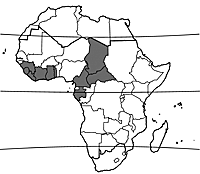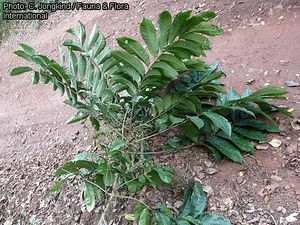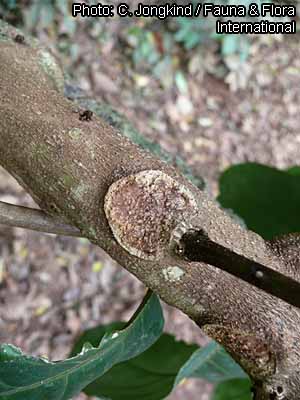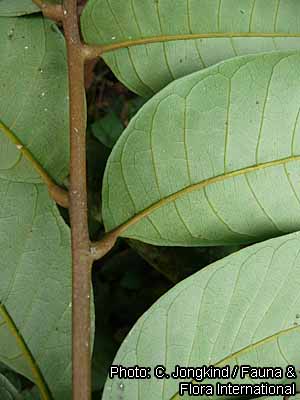Deinbollia grandifolia (PROTA)
Introduction |
| General importance | |
| Geographic coverage Africa | |
| Geographic coverage World | |
| Fruit | |
| Medicinal | |
| Timber | |
| Food security | |
Deinbollia grandifolia Hook.f.
- Protologue: Hook., Niger Fl.: 249 (1849).
- Family: Sapindaceae
Origin and geographic distribution
Deinbollia grandifolia occurs from Sierra Leone to Togo and also in Cameroon, Chad, the Central African Republic and Gabon.
Uses
The wood of Deinbollia grandifolia is used in West Africa for house building and for planks. The fleshy fruit pulp is edible and the slightly oily seeds are eaten as well. Juice from the mashed inner bark is used as eye-drops to treat jaundice.
Properties
The wood of Deinbollia grandifolia is pinkish white and not durable.
Description
- Shrub or small palm-like tree up to 8(–15) m tall; bole up to 30 cm in diameter; bark surface grey, scaly; twigs often zigzag, reddish with small white lenticels.
- Leaves alternate, paripinnately compound, up to 100 cm long, with (5–)7(–10) pairs of leaflets; stipules absent; petiole 10–27 cm long, rachis up to 60 cm long, grooved; petiolules c. 1 cm long; leaflets often alternate, sometimes opposite, oblong to narrowly obovate, 13–30 cm × 5–8 cm, cuneate and asymmetrical at base, acuminate at apex, papery, minutely hairy or scaly, pinnately veined with 12–16 pairs of lateral veins.
- Inflorescence an axillary panicle 10–20(–50) cm long, yellowish or brownish short-hairy.
- Flowers unisexual, regular, 5-merous, greenish yellow; pedicel 1.5–2 mm long; sepals free, rounded, up to 5 mm long, nearly glabrous; petals free, ovate, up to 4 mm long, hairy at margins, inside with 2 small scales at base; stamens 8–17; disk annular; ovary superior, 2–3-lobed, style up to 5 mm long.
- Fruit a globose to ovoid berry up to 1.5 cm long, fleshy, glabrous, orange when ripe, indehiscent, 1-seeded.
- Seed ovoid, c. 1 cm long, brown to blackish.
- Seedling with hypogeal germination; epicotyl c. 6 cm long, hairy; first 2 leaves opposite, with 2 elliptical leaflets up to 3.5 cm × 1.5 cm.
Other botanical information
Deinbollia comprises 30–40 species and occurs in tropical mainland Africa and Madagascar. The wood of many species developing into a tree is used.
Deinbollia cuneifolia
Deinbollia cuneifolia Baker is found from Guinea to Côte d’Ivoire and in Cameroon and Gabon. Although it is only a small tree up to 4 m tall, the wood is very hard and used for building. The fruit pulp is eaten. A steam bath, to which crushed bark and leaves are added, is prepared to overcome fatigue and as a cure for painful fevers.
Deinbollia fulvo-tomentella
Deinbollia fulvo-tomentella Baker f. (synonym: Deinbollia molliuscula Radlk.), a small tree of up to 9 m tall, occurs in the Central African Republic, Gabon, DR Congo, Uganda, Tanzania and Angola. In DR Congo its wood is used for construction.
Deinbollia macrocarpa and pervillei
At least 2 of the 7 endemic Deinbollia spp. of Madagascar are sought after for their wood. The wood of Deinbollia macrocarpa Capuron is used in boat building and for firewood. Deinbollia pervillei (Blume) Radlk. is appreciated for the quality and red colour of its wood, which is also used in boat building. It is also used as a support in vineyards and as firewood.
Ecology
Deinbollia grandifolia is usually found in the undergrowth of deciduous forest. It is quite shade tolerant.
Genetic resources
As Deinbollia grandifolia is widespread and not intensively exploited there seem to be no serious threats.
Prospects
The small stature of Deinbollia grandifolia and other Deinbollia spp. limits their usefulness as timber-producing trees.
Major references
- Burkill, H.M., 2000. The useful plants of West Tropical Africa. 2nd Edition. Volume 5, Families S–Z, Addenda. Royal Botanic Gardens, Kew, Richmond, United Kingdom. 686 pp.
- Hawthorne, W. & Jongkind, C., 2006. Woody plants of western African forests: a guide to the forest trees, shrubs and lianes from Senegal to Ghana. Kew Publishing, Royal Botanic Gardens, Kew, United Kingdom. 1023 pp.
- Menninger, A.D., 1977. Edible nuts of the world. Horticultural Books, Stuart FL, United States. 175 pp.
Other references
- Boiteau, P., Boiteau, M. & Allorge-Boiteau, L., 1999. Dictionnaire des noms malgaches de végétaux. 4 Volumes + Index des noms scientifiques avec leurs équivalents malgaches. Editions Alzieu, Grenoble, France.
- Brown, K.A., Ingram, J.C., Flynn, D.F.B., Razafindrazaka, R. & Jeannoda, V., 2009. Protected area safeguard tree and shrub communities from degradation and invasion: a case study in eastern Madagascar. Environmental Management 44:136–148
- Davies, F.G. & Verdcourt, B., 1998. Sapindaceae. In: Beentje, H.J. (Editor). Flora of Tropical East Africa. A.A. Balkema, Rotterdam, Netherlands. 108 pp.
- de la Mensbruge, G., 1966. La germination et les plantules des essences arborées de la forêt dense humide de la Côte d’Ivoire. Centre Technique Forestier Tropical, Nogent-sur-Marne, France. 389 pp.
- Fouilloy, R. & Hallé, N., 1973. Sapindacées. Flore du Cameroun. Volume 16. Muséum National d’Histoire Naturelle, Paris, France. 202 pp.
- Hauman, L., 1960. Sapindaceae. In: Robyns, W., Staner, P., Demaret, F., Germain, R., Gilbert, G., Hauman, L., Homès, M., Jurion, F., Lebrun, J., Vanden Abeele, M. & Boutique, R. (Editors). Flore du Congo belge et du Ruanda-Urundi. Spermatophytes. Volume 9. Institut National pour l’Étude Agronomique du Congo belge, Brussels, Belgium. pp. 279–384.
- Lisowski, S., 2009. Flore (Angiospermes) de la République de Guinée: première partie. Scripta Botanica Belgica. Volume 41. Jardin Botanique National de Belgique, Belgium. 517 pp.
- Martin, E.A., Ratsimisetra, Laloë, F. & Carrière, S.M., 2009. Conservation value for birds of traditionally managed isolated trees in an agricultural landscape of Madagascar. Biodiversity and Conservation 18: 2719–2742.
- Schatz, G.E., 2001. Generic tree flora of Madagascar. Royal Botanic Gardens, Kew, Richmond, United Kingdom. 477 pp.
Author(s)
- C.H. Bosch, PROTA Network Office Europe, Wageningen University, P.O. Box 341, 6700 AH Wageningen, Netherlands
Correct citation of this article
Bosch, C.H., 2011. Deinbollia grandifolia Hook.f. [Internet] Record from PROTA4U. Lemmens, R.H.M.J., Louppe, D. & Oteng-Amoako, A.A. (Editors). PROTA (Plant Resources of Tropical Africa / Ressources végétales de l’Afrique tropicale), Wageningen, Netherlands.
Accessed 18 December 2024.
- See the Prota4U database.




